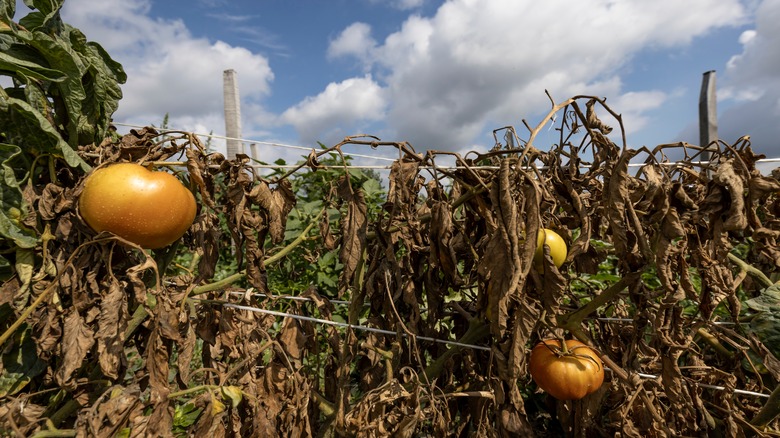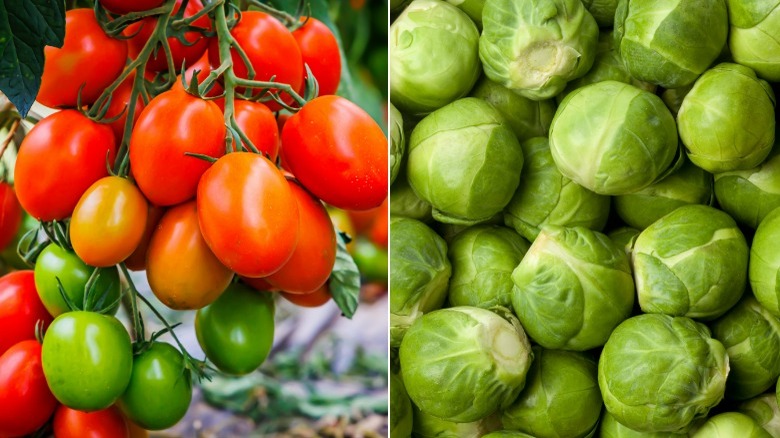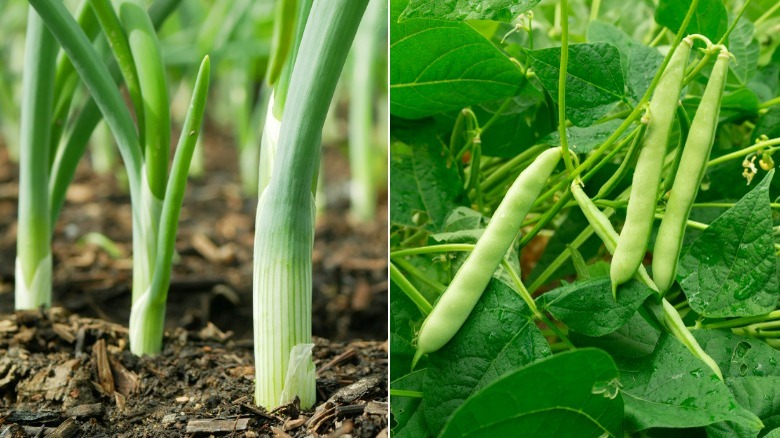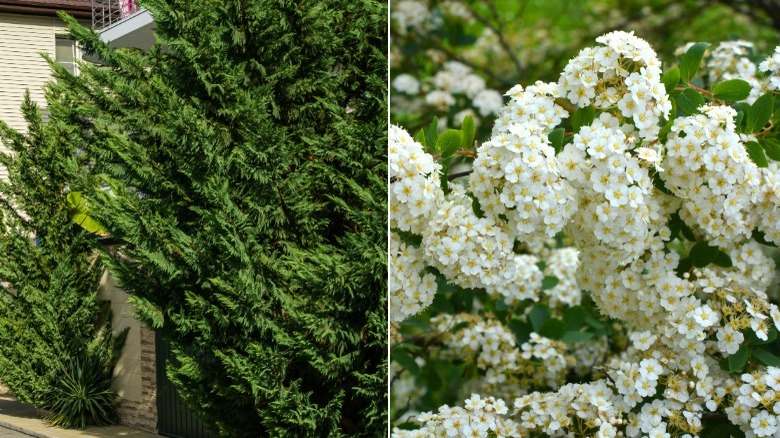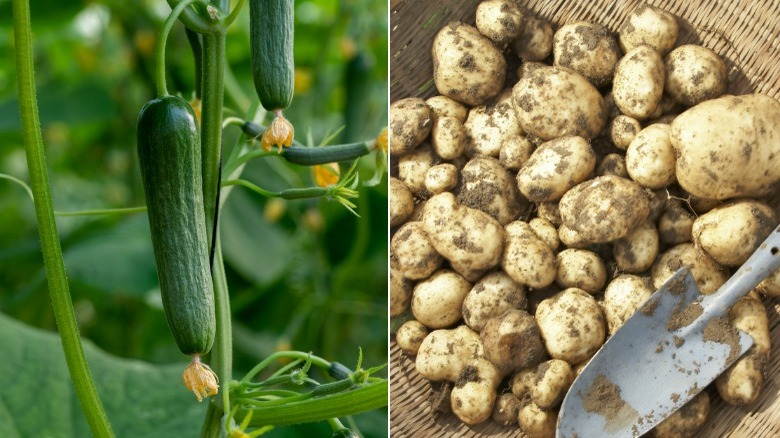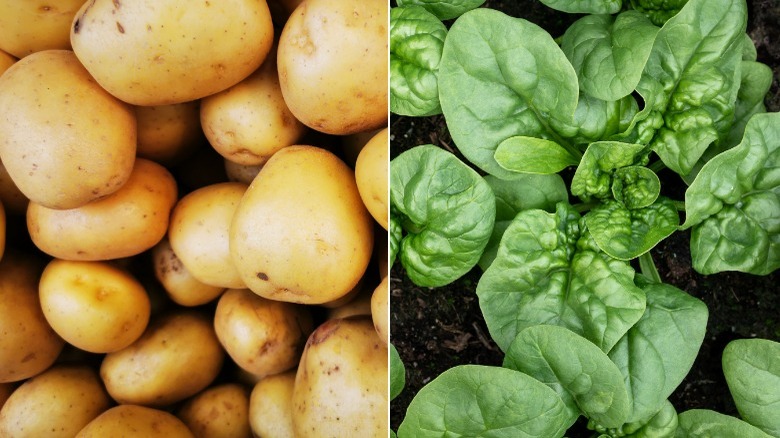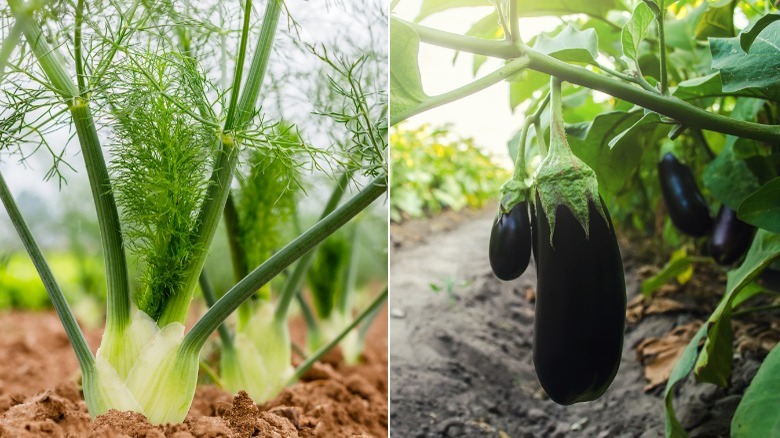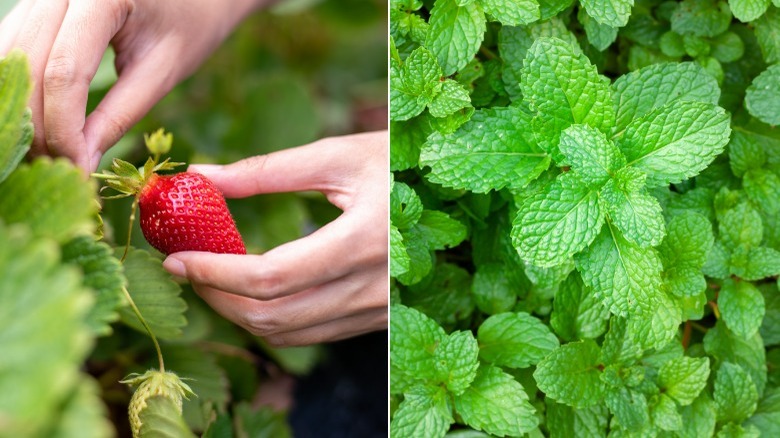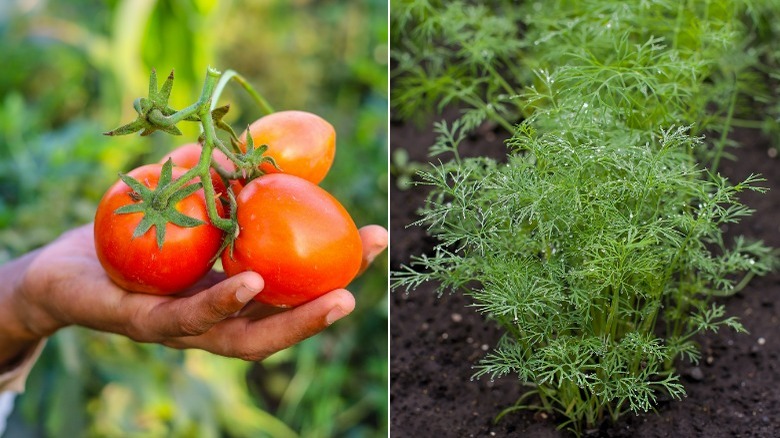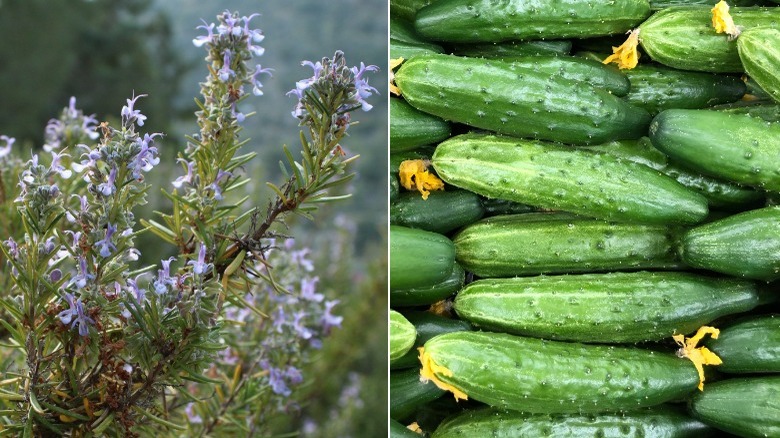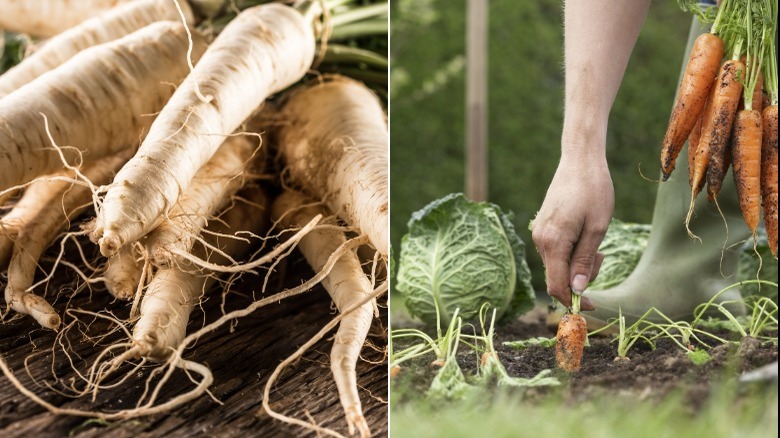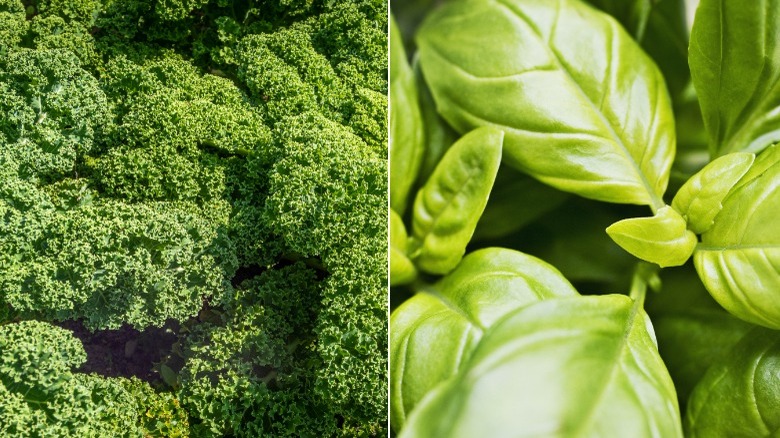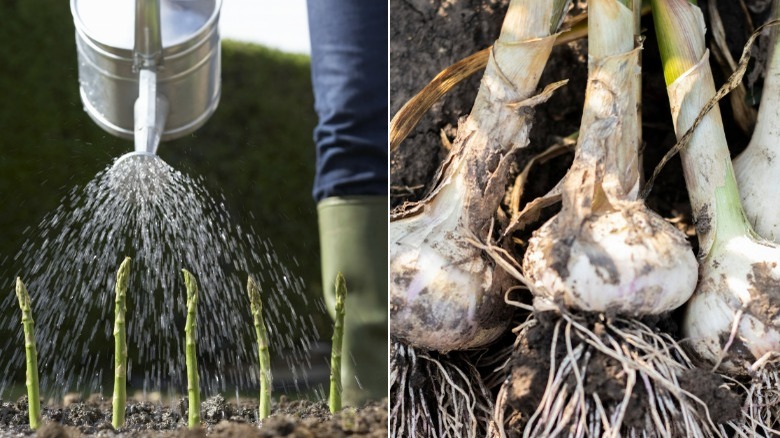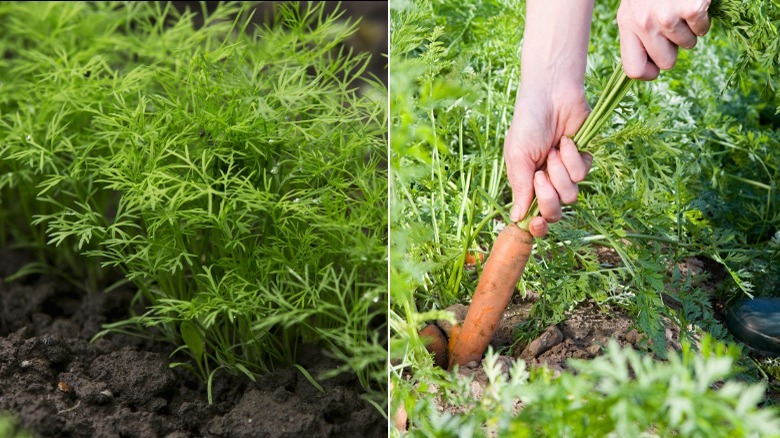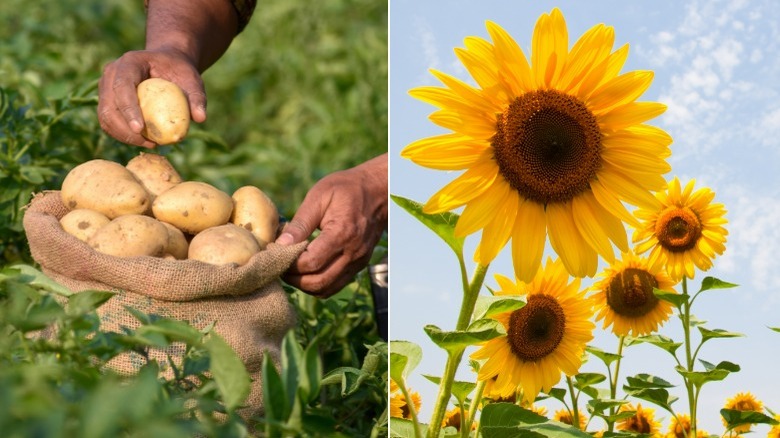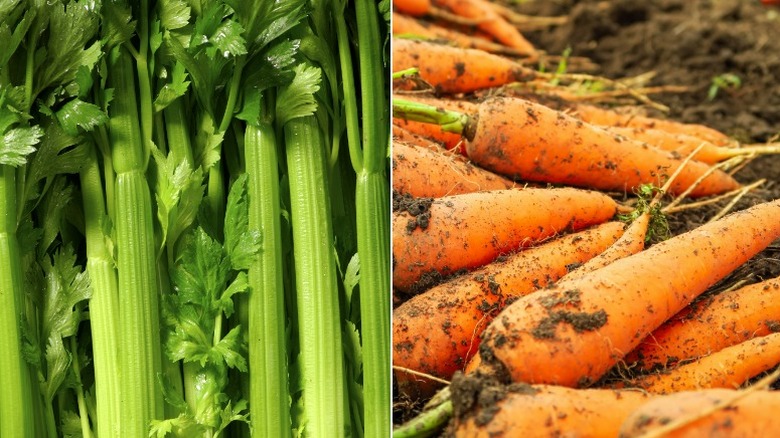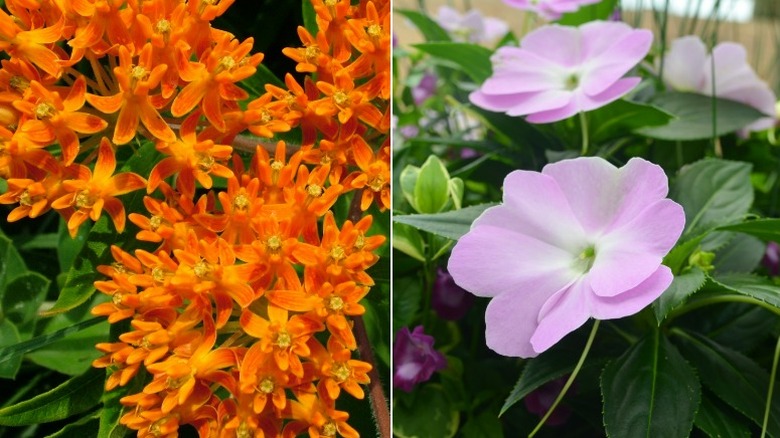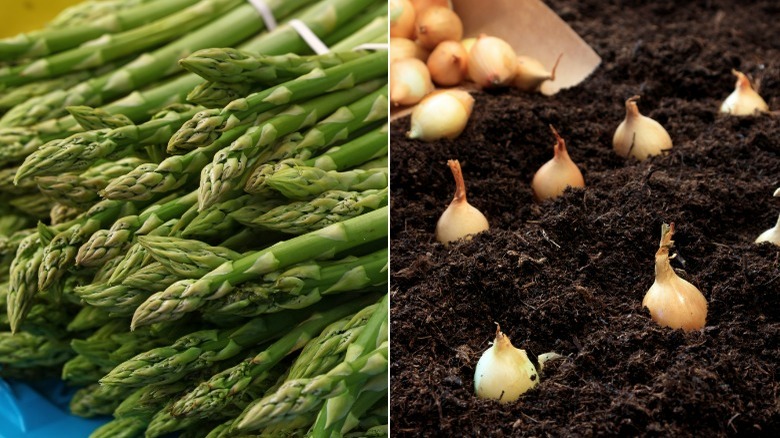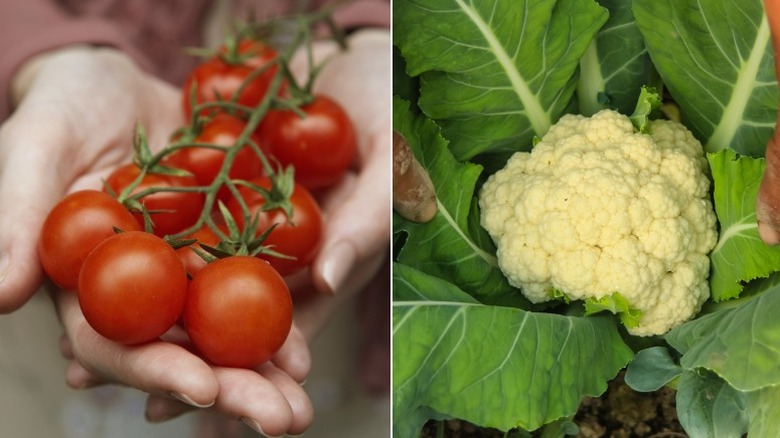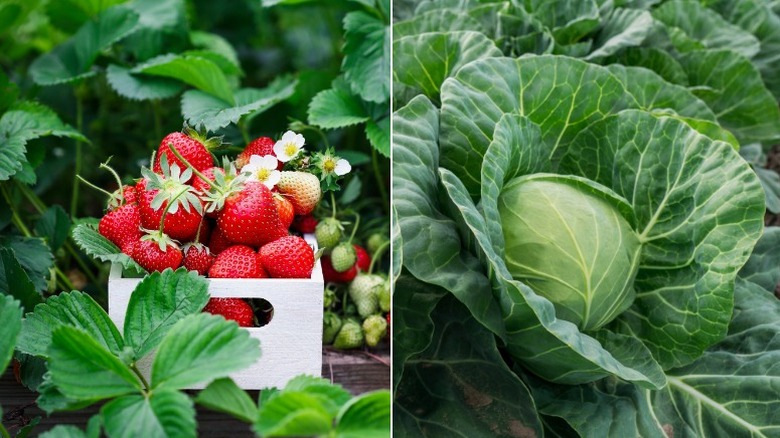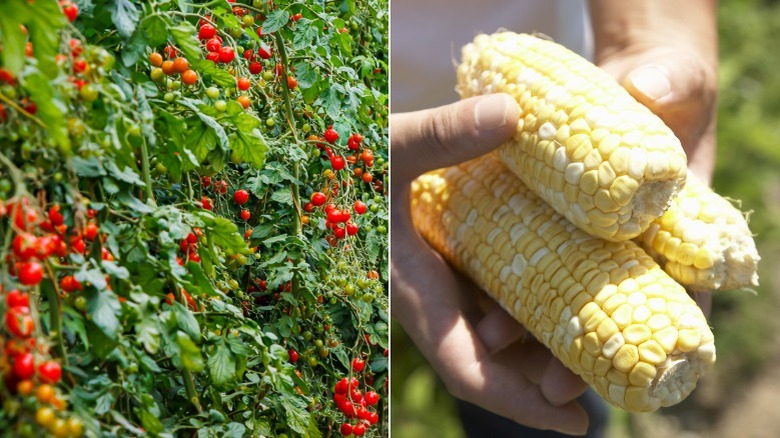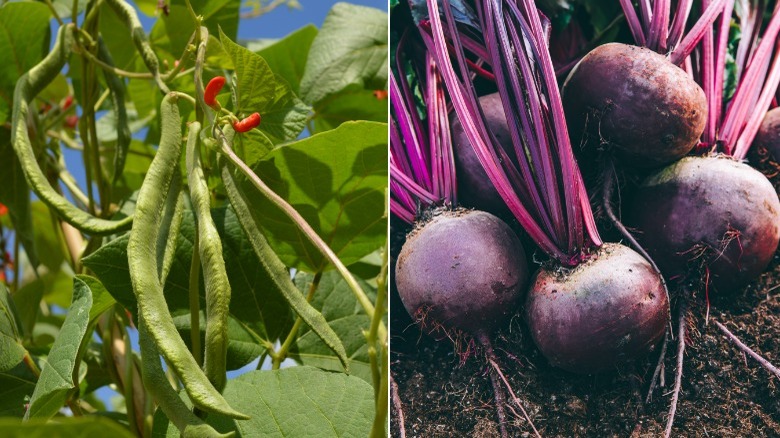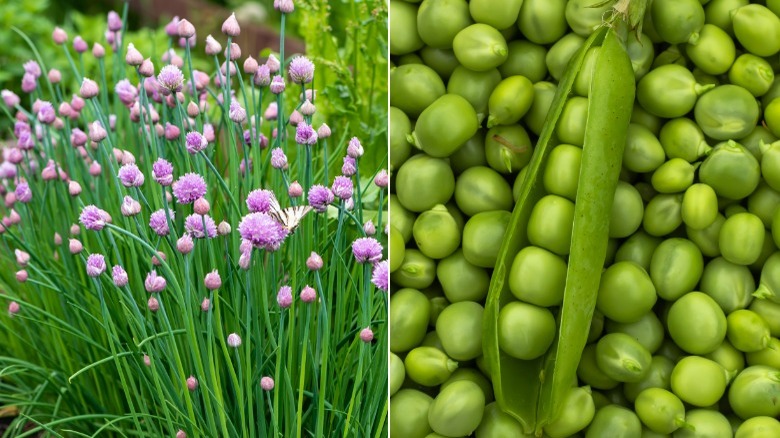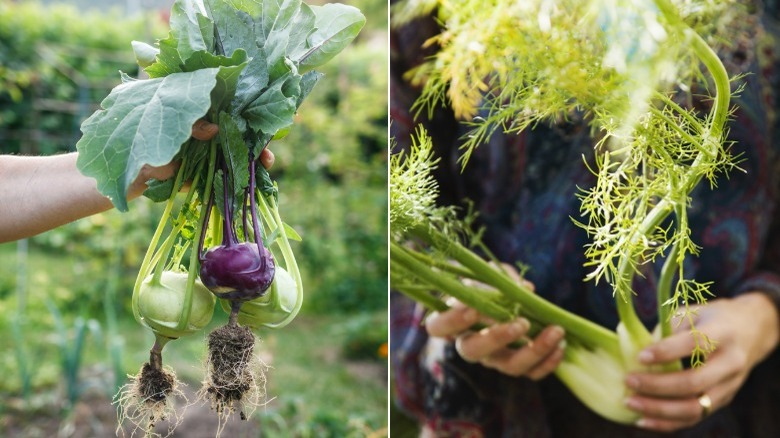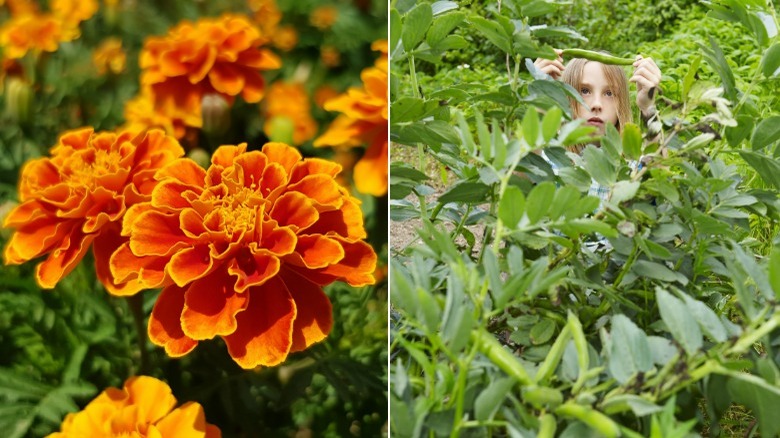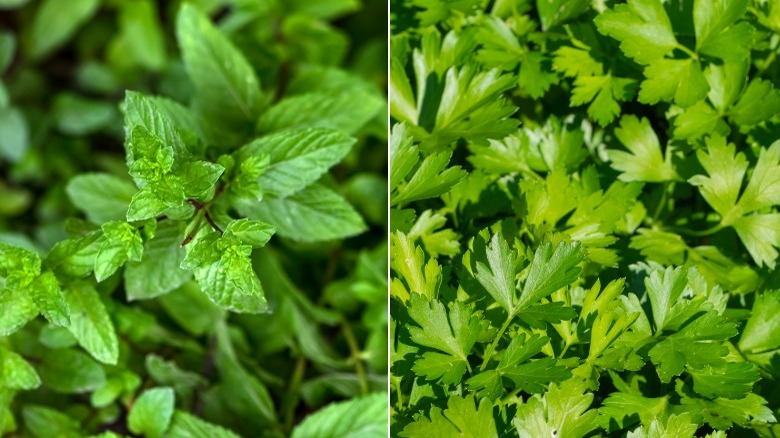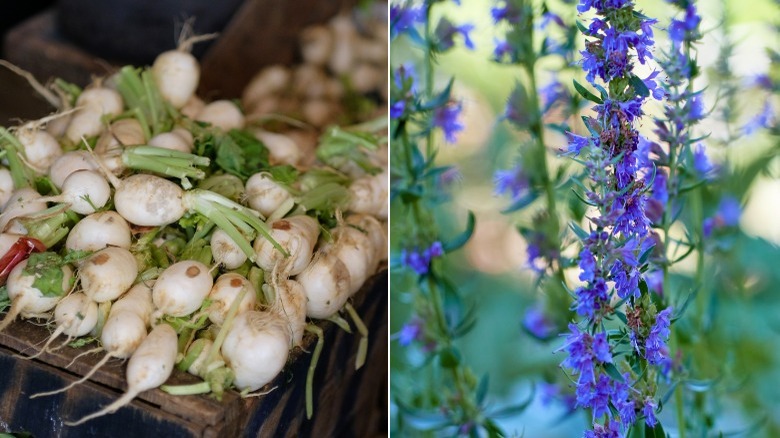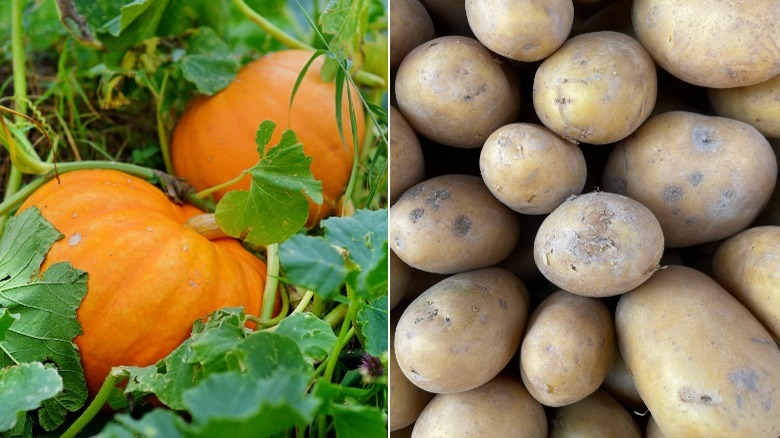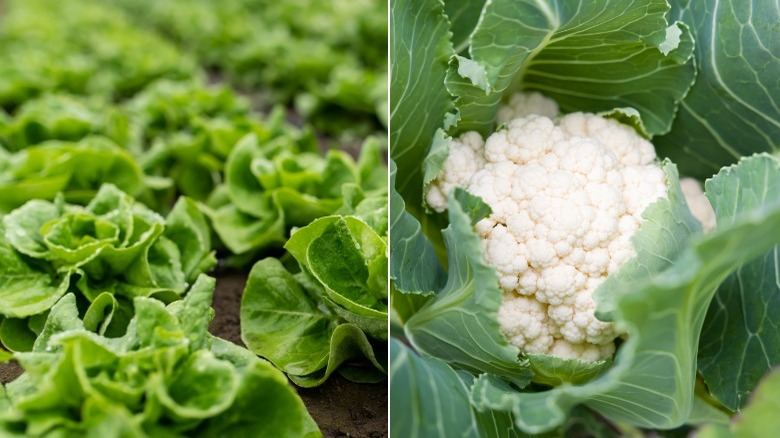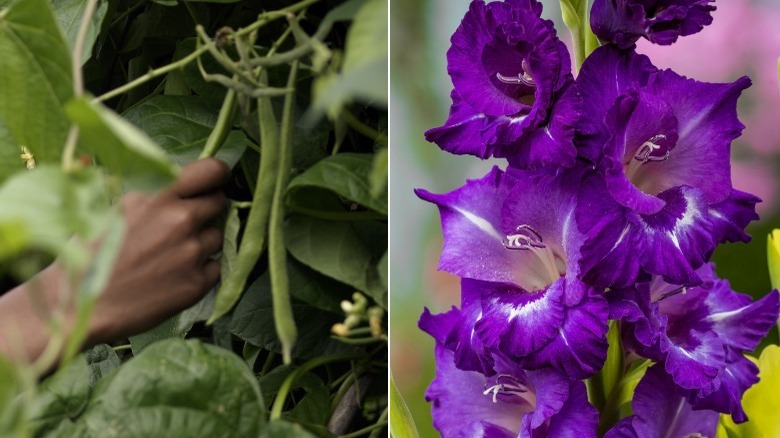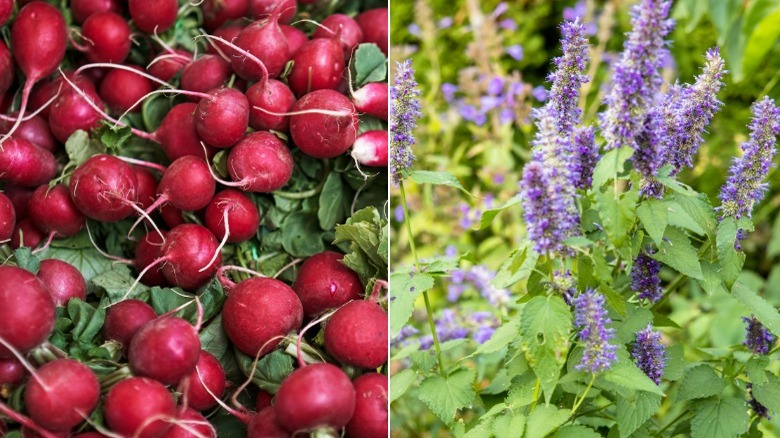30 Plant Pairs That Shouldn't Grow Next To Each Other
As spring approaches, avid gardeners start their seeds indoors and begin to figure out the best layout for their garden. This planning phase isn't as easy as choosing your favorite plants and randomly picking spots in the dirt. You must consider each plant's growing needs such as the amount of sunlight they enjoy, the type of soil they grow best in, and how much water they need to survive. You'll be disappointed when one or more of your crops don't grow properly due to their neighbor shading their leaves or stealing all the nutrients and water out from under them.
Plants that grow well together, or even help each other thrive, are called companion plants. Companion plants typically ward off pests looking to snack on their neighbor. They can also change the chemistry of the soil to help each other grow, or offer protection from bright sunlight and harsh winds. Finding a companion for your favorite fruit and vegetable plants is not difficult. What you should really focus on is making sure that you don't accidentally pair together two species that inhibit one another's growth. In this collection, we've pulled together several plant pairings that will do more harm than good when they're sharing a garden space.
1. Tomatoes and brussels sprouts
Tomatoes (Solanum lycopersicum) and Brussels sprouts (Brassica oleracea var. gemmifera) should not be planted together as they are both heavy feeders. Tomatoes, which are a member of the Solanaceae or nightshade family, require lots of vitamins and nutrients from rich and fertile soil. Brussels sprouts, from the Brassica genus, need many of the same. Additionally, they're both affected by aphids and flea beetles, which will cause a variety of issues when the pests find their way into your garden.
2. Beans and onions
Onions (Allium cepa) are usually welcome companion plants in the garden that help deter pests from snacking on tomatoes, lettuce, spinach, and strawberries growing there. However, this is not true for all garden plants. Beans (Phaseolus vulgaris) and onions should never be grown together as you will risk an outbreak of seedcorn maggots. Though seedcorn maggots usually feed on seedlings of corn and soybeans, they are known to inflict damage on young onion and bean plants as well, which can seriously affect your yield come harvest time.
3. Leyland cypress and spiraea
Even though they look beautiful together, Leyland cypress (Cupressocyparis leylandii) and spirea (Spiraea spp.) are really an ill-suited pairing. The cypress can grow up to 70 feet tall and 25 feet wide in a relatively short amount of time, while spiraea species will only grow between 1 and 8 feet tall depending on the cultivar. Spirea shrubs, that need consistent direct sunlight throughout the day, will begin to show leggy and unattractive growth when planted beneath a larger bush like Leyland cypress.
4. Cucumbers and potatoes
Similar to tomatoes and Brussels sprouts, potatoes (Solanum tuberosum) and cucumbers (Cucumis sativus) are to be kept away from each other due to their extreme need for nutrients. When planted together, potatoes and cucumbers will compete for almost everything including sunlight, space, water, pollination, and all of their necessary nutrients from the soil. It's best to keep the nightshade vegetable and Cucumis species in separate areas where they won't have to fight for their survival.
5. Potatoes and spinach
Potatoes are also one of the few plants that you shouldn't grow next to spinach (Spinacia oleracea). Spinach grows well with most vegetable plants like beans, broccoli, celery, peas, and strawberries, but potatoes tend to be a problem because of their aggressive growth habit. Spinach is both a weak competitor and a heavy feeder, which means planting them next to any other heavy feeder will usually result in failure for the spinach.
6. Fennel and eggplant
The fennel plant (Foeniculum vulgare) is something you want to keep out of your vegetable garden at all costs. Though its flowers and foliage can attract beneficial insects such as ladybird beetles, hoverflies, and parasitic wasps, it is known to inhibit the growth of several veggies, especially those in the nightshade family like tomatoes and eggplants. Eggplants (Solanum melongena) are already difficult to grow without fennel in the mix. Play it safe and keep these two away from each other.
7. Mint and strawberries
Mint (Mentha × piperita) is a heavily fragranced herb that will repel several pests. In the garden, this would be considered a good thing, but mint plants also have unmatched aggressive growth. They will quickly conquer weaker plants like strawberries (Fragaria × ananassa). Growing mint in a buried container can reduce its spread and help prevent damage to other plants. Regular heavy pruning in addition to containment may be necessary to make sure it's kept under control.
8. Dill and tomatoes
If they were personified, dill (Anethum graveolens) and tomatoes would be in a toxic relationship. When planted adjacent to tomatoes, dill plants are likely to do some harm and some good. A younger dill plant will be fine planted with tomatoes, and they may even ward off some pests or improve the taste of the fruit. However, as the dill matures, it will begin to stunt the growth of the tomatoes.
9. Rosemary and cucumbers
Cucumber plants require lots of water and sun. They like their soil to be rich and constantly moist, so they need to be watered often. Cucumbers that are grown vertically, which is recommended by many expert gardeners, need to be watered even more. This is in direct contrast to rosemary (Salvia rosmarinus) which prefers poor and well-drained soil. Rosemary is tolerant of drought so it can go without water for some time. If these two plants are grown as neighbors, one will surely die from too much or too little water.
10. Parsnips and carrots
Parsnips (Pastinaca sativa) and carrots (Daucus carota var. sativus) are both root crops. Root crops should normally have plenty of space between them so they aren't competing for essential nutrients like phosphorus below ground. Being root crops is not the only thing these two vegetables share. They're both members of the Apiaceae family, which means they're affected by many of the same pests and diseases. This includes the carrot root fly which is known for making carrots, parsnips, and celery inedible.
11. Kale and basil
Kale (Brassica oleracea var. sabellica) normally grows well with herbs. As a member of the Brassica genus, kale is threatened by several pests, but the herbs' intense fragrance helps to repel many of them. Growing kale next to basil (Ocimum basilicum) is a heavily debated topic. Some gardeners have no problems growing the two together, but others recommend keeping them apart as basil can influence the flavor of kale leaves. Basil is a member of the mint family and its bold flavor can alter the taste of plants grown nearby.
12. Asparagus and garlic
Asparagus (Asparagus officinalis) should not be grown with garlic (Allium sativum) or any other plant in the Allium genus for that matter. Grown together, the garlic will stunt the growth of the asparagus. This leads to lower yields and many small inedible stems. Thankfully, the two veggies can still be grown in the same garden bed. Just make sure that they're separated by planting a row of tomatoes, marigolds, or parsley between them to avoid problematic growth.
13. Dill and carrots
Dill is a bad match for all the plants in the parsley family which includes caraway, fennel, and carrots. Because they share many traits like attracting the same pests, growing dill and carrots together can lead to an infestation of carrot flies in your garden. Another problem that we frequently see is cross-pollination between the two species. When dill and carrots cross-pollinate they create hybrid plants with a bad flavor.
14. Potatoes and sunflowers
Potato plants and sunflowers (Helianthus annuus) are a problematic pair for a couple of reasons. Firstly, both potatoes and sunflowers can be affected by the blight fungus, Puccinia helianthi. The disease kills plants, but it can be removed if it's caught early. Planting the two species together can increase the chances of both plants being affected by blight. On top of that, the roots of the sunflowers emit substances into the soil that impairs the health of the potato tubers.
15. Celery and carrots
Celery (Apium graveolens var. dulce) and carrots are both members of the Apiaceae family. Rarely, do gardeners plant these in the same area because they are both harmed by the same pests. Carrot flies and wireworms are the worst of them. Both can make the vegetables experience stunted growth or render them inedible. Among the best ways to keep the pests at bay is to plant your celery and carrots in different parts of the garden.
16. Butterfly weed and impatiens
Butterfly weeds (Asclepias tuberosa) and impatiens (Impatiens spp.) are both gorgeous flowering plants that attract pollinators and brighten up your garden all summer long. Sadly, the two should not be planted right next to each other. The two flowers have nearly opposite growing requirements. While butterfly weeds prefer direct sunlight, little water, and dry sandy soil, impatiens need shade and very moist and rich soil. Still, you could grow them in two containers nearby one another to benefit from their pollinator-friendly flowers.
17. Onion and asparagus
Onions are bad for pairing with asparagus because of their unfortunate ability to attract onion maggots and beet armyworms. Both pests travel easily from plant to plant, and when the two plants are nearby one another, it only gives them more material to mangle. Asparagus can also be harmed by the onions on their own. Onions and other members of the Allium genus are known to stunt asparagus growth when they are planted too near each other in the same soil.
18. Tomatoes and cauliflower
Tomatoes and cauliflower (Brassica oleracea, Botrytis Group) are both healthful veggies that work well together in many dishes. Yet, if you want both of them to grow properly in the garden, you must keep them a good distance away from one another. Brassicas such as cauliflower will inhibit tomato plant growth and leave you with a disappointing yield or no harvest at all. Along with this, keeping them apart will ensure that they won't need to fight over nutrients in the soil like nitrogen.
19. Cabbage and strawberries
Both strawberries and cabbage (Brassica oleracea var. capitata) are commonly affected by verticillium wilt. Verticillium wilt is caused by a fungus that can spread to a wide variety of plants. Once the disease enters the cabbage and strawberry plants, it's incurable and the plants will need to be removed from the garden and destroyed. Verticillium wilt can be kept away from your crops by planting cultivars with disease resistance and keeping plants that are very susceptible to it away from each other, such as these two.
20. Tomatoes and corn
Tomatoes and corn (Zea mays) are another pair of vegetables that share the same pests. Both plants are affected by the cotton bollworm, which is sometimes known as the tomato fruit worm or the corn earworm. Planting the two species next to each other only invites these worms to feed on the buffet you provided them. Yet, this isn't the only reason to keep tomatoes and corn away from each other. They will also compete for sunlight, water, and nutrients in the soil which can be damaging to one or both plants.
21. Pole beans and beets
Pole beans (Phaseolus coccineus), also known as snap beans, runner beans, or scarlet runner beans, are a member of the pea family and are usually grown as annuals despite being a perennial twining vine. They do not grow well with beets (Beta vulgaris subsp. vulgaris). Grown together, these two vegetable plants will stunt each other's growth. Additionally, too much nitrogen produced by the beans can seriously affect the quality of the beets.
22. Chives and peas
Peas (Pisum sativum) should never be planted with Alliums. This includes chives (Allium schoenoprasum) as well as onions, shallots, and leeks. Peas and chives compete for many of the same nutrients in the soil. When either plant is unable to receive the nutrients they need, it will affect its taste and ability to grow properly. Planting peas and chives too near each other could lead to one or both plants' death, so keep them far away from each other to avoid this.
23. Kohlrabi and fennel
Kohlrabi (Brassica oleracea, Gongylodes Group) is a lesser-known vegetable from the broccoli family that produces a bulb-like fruit with several edible leaves. Kohlrabi is typically steamed for use in a stir fry, pasta, stew, or soup, and it can even be mashed like potatoes. If you want to grow a healthy kohlrabi plant do not grow it near fennel. The fennel plant will inhibit growth in kohlrabi and leave you with a disappointing harvest.
24. French marigolds and beans
You would think that you could grow French marigolds (Tagetes patula) with any vegetable plant to ward off pests such as whiteflies, bean beetles, and nematodes. Yet, there is one vegetable that will not benefit from the marigolds' natural pesticidal abilities. Beans are not friendly with French marigolds because they are both attacked by spider mites. Spider mites will quickly infest a garden, covering plants with gray webbing and sucking the plant juices from both species.
25. Mint and parsley
When you think of herbs, it's likely that mint and parsley (Petroselinum crispum) are two plants that come to mind. However, if you're looking to create a thriving herb garden, you should choose one or the other. These two herbs do not grow well if they are positioned too close to one another. Mint's aggressive growth habit will quickly overtake parsley, which is a weaker competitor. In fact, it's best not to plant mint in the garden at all.
26. Radishes and hyssop
Hyssop (Hyssopus officinalis) is a member of the mint family and grows best in direct sunlight in soils that are on the dryer side. Radishes (Raphanus sativus) enjoy the same growing conditions, but it's unwise to grow these two plants as neighbors because hyssop can be counterproductive for radish growth. Instead, choose to plant radishes close to beets, beans, melons, or nasturtium. Alternatively, radishes could be planted near squash to deter squash borers.
27. Pumpkins and potatoes
Pumpkins (Cucurbita maxima) and potatoes make bad neighbors because both need plenty of space in the soil to grow their roots and suck up nutrients from the ground. When they're made to share the same area of the garden, it's not out of the realm of possibility that the roots of the potatoes will disturb the pumpkin roots as they grow larger. All of this can lead to poor growth, an infestation of certain beetles, and even fungal disease.
28. Lettuce and cauliflower
Even though the plants can look similar, lettuce (Lactuca sativa) and cauliflower should not be planted together. Cauliflower, along with some other plants in the Brassica genus deter lettuce growth. In some instances even before the plants begin to grow, root secretions from cauliflower can keep lettuce seeds from germinating. If the lettuce does somehow grow next to a cauliflower plant, the two will fight over essential nutrients in the soil and produce problematic growth. Growing these as neighbors is a lose-lose.
29. Beans and gladiolus
If you're trying to liven up your garden near your bean plants, cross off gladiolus (Gladiolus spp.) from your list of possible candidates. Though they are extremely beautiful flowers, they actually inhibit the growth of beans. It's not just a one-way street either, when planted too close to beans, the gladiolus will show stunted growth as well. If you're intent on growing flowers in your bean garden, or vise-versa, try nasturtium and rosemary.
30. Radishes and agastache
Agastache (Agastache foeniculum) grows well with flowering herbs like lavender, rosemary, and catmint. But, it also has a couple of enemies and radishes are one of them. If you try to grow agastache and radishes too near each other, they may fight for nutrients and space. Both have a high need for rich soil to grow properly, and agastache, as a member of the mint family, is likely to take over your radishes as they can show some pretty aggressive growth.
